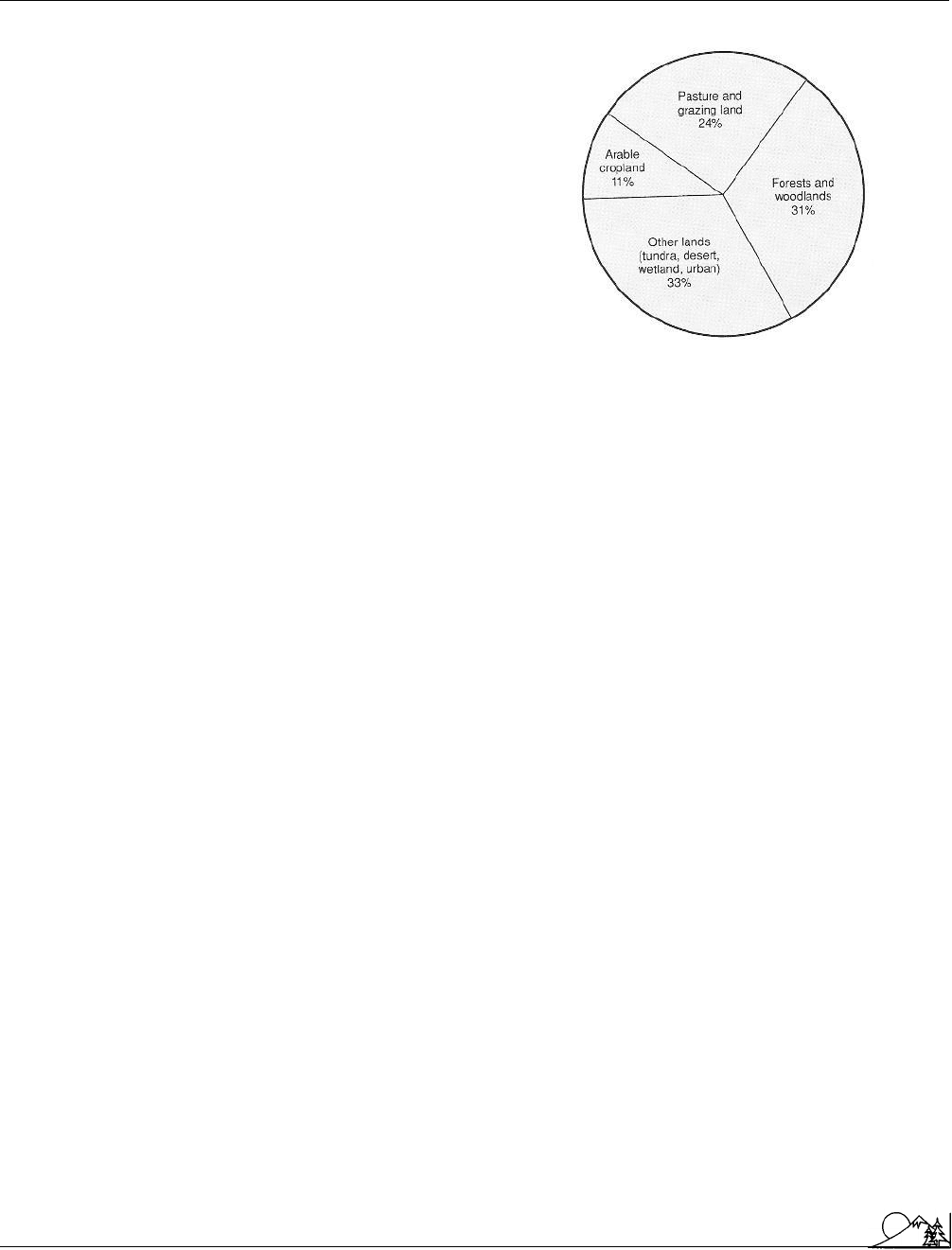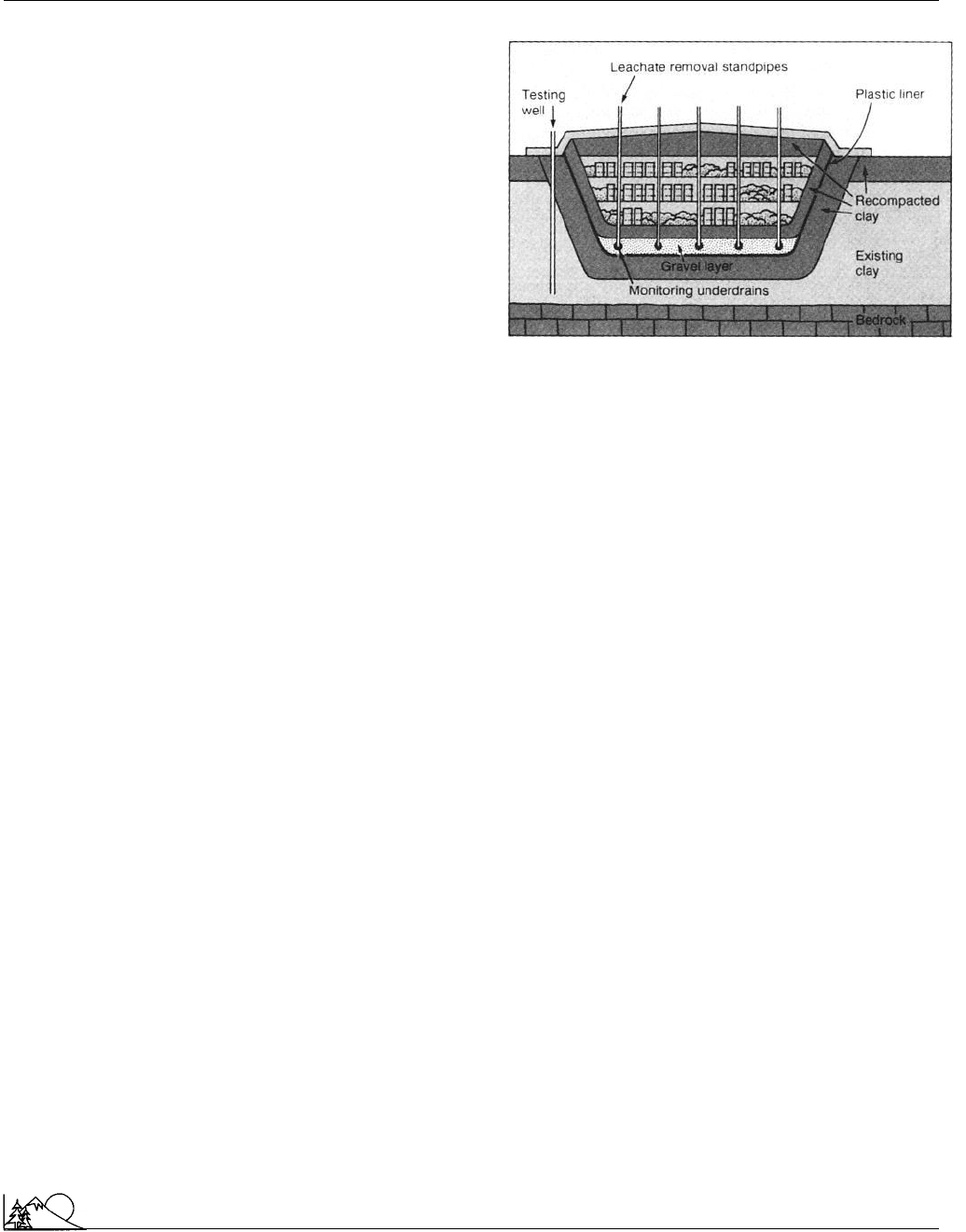Environmental Encyclopedia
Подождите немного. Документ загружается.


Environmental Encyclopedia 3
Lake Tahoe
O
THER
“Zebra Mussels and Other Nonindigenous Species.” Sea Grant Great Lakes
Network. August 15, 2001 [June 19, 2002]. <http://www.seagrant.wisc.edu/
greatlakes/glnetwork/exotics.html>.
Lake Tahoe
A beautiful lake 6,200 ft (1,891 m) high in the Sierra Nevada,
straddling the California-Nevada state line, Lake Tahoe is
a jewel to both nature-lovers and developers. It is the tenth
deepest lake in the world, with a maximum depth of 1,600
ft (488 m) and a total volume of 37 trillion gallons. At the
south end of the lake sits a dam that supplies up to six feet
of Lake Tahoe’s water flow into the outlet of the Truckee
River. The U.S.
Bureau of Reclamation
controls water
diversion into the Truckee, which is used for
irrigation
,
power, and recreational purposes throughout Nevada.
Tahoe and Crater Lake are the only two large alpine
lakes remaining in the United States. Visitors have expressed
their awe of the lake’s beauty since it was discovered by
General John Fre
´
mont in 1844. Mark Twain wrote that it
was “the fairest sight the whole Earth affords.”
The arrival of Europeans in the Tahoe area was quickly
followed by environmental devastation. Between 1870 and
1900, forests around the lake were heavily logged to provide
timber for the mine shafts of the Comstock Lode. While
this
logging
dramatically altered the area’s appearance for
years, the natural
environment
eventually recovered and no
long-term logging-related damage to the lake can now be
detected.
The same can not be said for a later assault on the
lake’s environment. Shortly after World War II, people be-
gan moving into the area to take advantage of the region’s
natural wonders—the lake itself and superb snow skiing—
as well as the young casino business on the Nevada side of
the lake. The 1960 Winter Olympics, held at Squaw Valley,
placed Tahoe’s recreational assets in the international spot-
light. Lakeside population grew from about 20,000 in 1960
to more than 65,000 today, with an estimated tourist popula-
tion of 22 million annually.
The impact of this rapid
population growth
soon
became apparent in the lake itself. Early records showed
that the lake was once clear enough to allow
visibility
to a
depth of about 130 ft (40 m). By the late 1960s, that figure
had dropped to about 100 ft (30 m).
Tahoe is now undergoing eutrophication at a fairly
rapid rate. Algal growth is being encouraged by sewage and
fertilizer
produced by human activities. Much of the area’s
natural
pollution
controls, such as trees and plants, have
been removed to make room for residential and commercial
development. The lack of significant flow into and out of
807
the lake also contributes to a favorable environment for algal
growth.
Efforts to protect the pristine beauty of Lake Tahoe
go back at least to 1912. Three efforts were made during
that decade to have the lake declared a
national park
, but
all failed. By 1958, concerned conservationists had formed
the Lake Tahoe Area Council to “promote the preservation
and long-range development of the Lake Tahoe basin.” The
Council was followed by other organizations with similar
objectives, the League to Save Lake Tahoe among them.
An important step in resolving the conflict between
preservationists and developers occurred in 1969 with the
creation of the Tahoe Regional Planning Agency (TRPA).
The agency was the first and only
land use
commission
with authority in more than one state. It consisted of fourteen
members, seven appointed by each of the governors of the
two states involved, California and Nevada. For more than
a decade, the agency attempted to write a land-use plan that
would be acceptable to both sides of the dispute. The conflict
became more complex when the California Attorney Gen-
eral, John Van de Kamp, filed suit in 1985 to prevent TRPA
from granting any further permits for development. Devel-
opers were outraged but lost all of their court appeals.
By 2000, the strain of tourism, development, and non-
point
automobile
pollution was having a visible impact on
Lake Tahoe’s legendary deep blue surface. A study released
by the University of California—Davis and the University
of Nevada—Reno reported that visibility in the lake had
decreased to 70 ft (21 m), an average decline of a foot a year
since the 1960s. As part of a renewed effort to reverse Tahoe’s
environmental decline, President Clinton signed the Lake
Tahoe Restoration Act into law in late 2000, authorizing
$300 million towards restoration of
water quality
in Lake
Tahoe over a period of 10 years. See also Algal bloom; Cul-
tural eutrophication; Environmental degradation; Fish kills;
Sierra Club; Water pollution
[David E. Newton and Paula Anne Ford-Martin]
R
ESOURCES
B
OOKS
Strong, Douglas. Tahoe: From Timber Barons to Ecologists.Lincoln, NE:
Bison Books, 1999.
O
THER
United States Department of Agriculture (USDA) Forest Service. Lake
Tahoe Basin Management Unit. [cited July 8, 2002]. <http://
www.r5.fs.fed.us/ltbmu>.
University of California-Davis. Tahoe Research Group. [cited July 8, 2002].
<http://trg.ucdavis.edu/default.html>.
United States Geological Survey (USGS) Lake Tahoe Data Clearinghouse.
Lake Tahoe Data Clearinghouse. [cited July 8, 2002]. <http://tahoe.usgs.gov/
intro.html>.

Environmental Encyclopedia 3
Lake Washington
Lake Washington
One of the great messages to come out of the environmental
movement of the 1960s and 1970s is that, while humans
can cause
pollution
, they can also clean it up. Few success
stories illustrate this point as clearly as that of Lake Washing-
ton. Lake Washington lies along the state of Washington’s
west coastline, near the city of Seattle. It is 24 miles (39
km) from north to south and its width varies from 2–4 miles
(3–6 km).
For the first half of this century, Lake Washington
was clear and pristine, a beautiful example of the Northwest’s
spectacular natural scenery. Its shores were occupied by ex-
tensive wooded areas and a few small towns with populations
of no more than 10,000. The lake’s purity was not threatened
by Seattle, which dumped most of its wastes into Elliot Bay,
an arm of Puget Sound. This situation changed rapidly
during and after World War II. In 1940, the spectacular
Lake Washington Bridge was built across the lake, joining
its two facing shores with each other and with Seattle. Popu-
lation along the lake began to boom, reaching more than
50,000 by 1950.
The consequence of these changes for the lake are easy
to imagine. Many of the growing communities dumped their
raw sewage directly into the lake or, at best, passed their
wastes though only preliminary treatment stages. By one
estimate, 20 million gallons (76 million liters) of wastes were
being dumped into the lake each day. On average these
wastes still contained about half of their pollutants when
they reached the lake. In less than a decade, the effect of
these practices on lake
water quality
were easy to observe.
Water clarity was reduced from at least 15 ft (4.6 m) to 2.5
ft (0.8 m) and levels of
dissolved oxygen
were so low
that some
species
of fish disappeared. In 1956, W. T.
Edmonson, a zoologist and pollution authority, and two
colleagues reported their studies of the lake. They found
that eutrophication of the lake was taking place very rapidly
as a result of the dumping of domestic wastes into its water.
Solving this problem was especially difficult because
water pollution
is a regional issue over which each individ-
ual community had relatively little control. The solution
appeared to be the creation of a new governmental body that
would encompass all of the Lake Washington communities,
including Seattle. In 1958, a ballot measure establishing
such an agency, known as Metro, was passed in Seattle but
defeated in its suburbs. Six months later, the Metro concept
was redefined to include the issue of sewage disposal only.
This time it passed in all communities.
Metro’s approach to the Lake Washington problem
was to construct a network of sewer lines and
sewage
treatment
plants that directed all sewage away from the
lake and delivered it instead to Puget Sound. The lake’s
808
pollution problems were solved within a few years. By 1975
the lake was back to normal, water clarity returned to 15 ft
and levels of potassium and
nitrogen
in the lake decreased by
more than 60 percent. Lake Washington’s biological oxygen
demand (BOD), a critical measure of water purity, decreased
by 90 percent and fish species that had disappeared were
once again found in the lake. See also Aquatic chemistry;
Cultural eutrophication; Waste management; Water quality
standards
[David E. Newton]
R
ESOURCES
B
OOKS
Edmonson, W. T. “Lake Washington.” In Environmental Quality and
Water Development, edited by C. R. Goodman, et al. San Francisco: W.
H. Freeman, 1973.
———. The Uses of Ecology: Lake Washington and Beyond. Seattle: University
of Washington Press, 1991.
O
THER
Li, Kevin. “The Lake Washington Story.” King County Web Site. May 2,
2001 [June 19,2002]. <http://dnr.metrokc.gov/wlr/waterres/lakes/biola-
ke.htm>.
Lakes
see
Experimental Lakes Area; Lake
Baikal; Lake Erie; Lake Tahoe; Lake
Washington; Mono Lake; National lakeshore
Land degradation
see
Desertification
Land ethic
Land ethic refers to an approach to issues of
land use
that emphasizes
conservation
and respect for our natural
environment
. Rejecting the belief that all
natural re-
sources
should be available for unchecked human exploita-
tion, a land ethic advocates land use without undue distur-
bances of the complex, delicately balanced ecological systems
of which humans are a part. Land ethic,
environmental
ethics
, and ecological ethics are sometimes used inter-
changeably.
Discussions of land ethic, especially in the United
States, usually begin with a reference of some kind to
Aldo
Leopold
. Many participants in the debate over land and
resource use admire Leopold’s prescient and pioneering quest
and date the beginnings of a land ethic to his A Sand County
Almanac, published in 1949. However, Leopold’s earliest

Environmental Encyclopedia 3
Land Institute
formulation of his position may be found in “A Conservation
Ethic,” a benchmark essay on ethics published in 1933.
Even recognizing Leopold’s remarkable early contri-
bution, it is still necessary to place his pioneer work in a
larger context. Land ethic is not a radically new invention
of the twentieth century but has many ancient and modern
antecedents in the Western philosophical tradition. The
Greek philosopher Plato, for example, wrote that morality
is “the effective harmony of the whole"—not a bad statement
of an ecological ethic. Reckless exploitation has at times been
justified as enjoying divine sanction in the Judeo-Christian
tradition (man was made master of the creation, authorized
to do with it as he saw fit). However, most Christian thought
through the ages has interpreted the proper human role as
one of careful husbandry of resources that do not, in fact,
belong to humans. In the nineteenth century, the Huxleys,
Thomas and Julian, worked on relating
evolution
and ethics.
The mathematician and philosopher Bertrand Russell wrote
that “man is not a solitary animal, and so long as social life
survives, self-realization cannot be the supreme principle of
ethics.”
Albert Schweitzer
became famous—at about the
same time that Leopold formulated a land ethic—for teach-
ing reverence for life, and not just human life. Many non-
western traditions also emphasize harmony and a respect for
all living things. Such a context implies that a land ethic
cannot easily be separated from age-old thinking on ethics
in general. See also Land stewardship
[Gerald L. Young and Marijke Rijsberman]
R
ESOURCES
B
OOKS
Bormann, F. H., and S. R. Kellert, eds. Ecology, Economics, Ethics: The
Broken Circle. New Haven, CT: Yale University Press, 1991.
Kealey, D. A. Revisioning Environmental Ethics. Albany: State University
of New York Press, 1989.
Leopold, A. A Sand County Almanac. New York: Oxford University
Press, 1949.
Nash, R. F. The Rights of Nature: A History of Environmental Ethics. Madi-
son: University of Wisconsin Press, 1989.
Rolston, H. Environmental Ethics. Philadelphia: Temple University
Press, 1988.
Turner, F. “A New Ecological Ethics.” In Rebirth of Value. Albany: State
University of New York Press, 1991.
O
THER
Callicott, J. Baird. “The Land Ethic: Key Philosophical and Scientific
Challenges.” October 15, 1998 [June 19, 2002]. <http://www.orst.edu/
dept/philosophy/ideas/leopold/presentations/callicott/pres-03.html>.
Land Institute
Founded in 1976 by Wes and Dana Jackson, the Land
Institute is both an independent agricultural research station
809
and a school devoted to exploring and developing alternative
agricultural practices. Located on the Smoky Hill River near
Salina, Kansas, the Institute attempts—in Wes Jackson’s
words—to “make
nature
the measure” of human activities
so that humans “meet the expectations of the land,” rather
than abusing the land for human needs. This requires a
radical rethinking of traditional and modern farming meth-
ods. The aim of the Land Institute is to find “new roots for
agriculture” by reexamining its traditional assumptions.
In traditional tillage farming, furrows are dug into
the
topsoil
and seeds planted. This leaves precious topsoil
exposed to
erosion
by wind and water. Topsoil loss can be
minimized but not eliminated by
contour plowing
, the
use of windbreaks, and other means. Although critical of
traditional tillage agriculture, Jackson is even more critical of
the methods and machinery of modern industrial agriculture,
which in effect trades topsoil for high crop yields (roughly
one bushel of topsoil is lost for every bushel of corn har-
vested). It also relies on plant monocultures—genetically
uniform strains of corn, wheat, soybeans, and other crops.
These crops are especially susceptible to disease and insect
infestations and require extensive use of pesticides and herbi-
cides which, in turn, kill useful creatures (for example, worms
and birds), pollute streams and
groundwater
, and produce
other destructive side effects. Although spectacularly suc-
cessful in the short run, such an agriculture is both non-
sustainable and self-defeating. Its supposed strengths—its
productivity, its efficiency, its economies of scale—are also its
weaknesses. Short-term gains in production do not, Jackson
argues, justify the longer term depletion of topsoil, the dimi-
nution of genetic diversity, and such social side-effects as the
disappearance of small family farms and the abandonment of
rural communities.
If these trends are to be questioned—much less slowed
or reversed—a practical, productive, and feasible alternative
agriculture must be developed. To develop such a workable
alternative is the aim of the Land Institute. The Jacksons
and their associates are attempting to devise an alternative
vision of agricultural possibilities. This begins with the im-
portant but oft-neglected truism that agriculture is not self-
contained but is intertwined with and dependent on nature.
The Institute explores the feasibility of alternative farming
methods that might minimize or even eliminate the planting
and harvesting of annual crops, turning instead to “herba-
ceous perennial seed-producing polycultures” that protect
and bind topsoil. Food grains would be grown in pasture-
like fields and intermingled with other plants that would
replenish lost
nitrogen
and other nutrients, without relying
on chemical fertilizers. Covered by a rooted living net of
diverse plant life, the
soil
would at no time be exposed to
erosion and would be aerated and rejuvenated by natural

Environmental Encyclopedia 3
Land reform
means. And the farmer, in symbiotic partnership, would
take nature as the measure of his methods and results.
The experiments at the Land Institute are intended
to make this vision into a workable reality. It is as yet too
early to tell exactly what these continuing experiments might
yield. But the re-visioning of agriculture has already begun
and continues at the Land Institute.
[Terence Ball]
R
ESOURCES
O
RGANIZATIONS
The Land Institute, 2440 E. Water Well Road, Salina, KS USA 67401
(785) 823-5376, Fax: (785) 823-8728, Email: thelandweb@
landinstitute.org, <http://www.landinstitute.org>
Land reform
Land reform is a social and political restructuring of the
agricultural systems through redistribution of land. Success-
ful land reform policies take into account the political, social,
and economic structure of the area.
In agrarian societies, large landowners typically control
the wealth and the distribution of food. Land reform policies
in such societies allocate land to small landowners, to farm
workers who own no land, to collective farm operations, or
to state farm organizations. The exact nature of the allocation
depends on the motivation of those initiating the changes.
In areas where absentee ownership of farmland is common,
land reform has become a popular method for returning the
land to local ownership. Land reforms generally favor the
family-farm concept, rather than absentee landholding.
Land reform is often undertaken as a means of achiev-
ing greater social equality, but it can also increase agricultural
productivity and benefit the
environment
. A tenant farmer
may have a more emotional and protective relation to the
land he works, and he may be more likely to make agricultural
decisions that benefit the
ecosystem
. Such a farmer might,
for instance, opt for natural
pest
control. An absentee owner
often does not have the same interest in
land stewardship
.
Land reform does have negative connotations and is
often associated with the state collective farms under com-
munism. Most proponents of land reform, however, do not
consider these collective farms good examples, and they ar-
gue that successful land reform balances the factors of pro-
duction so that the full agricultural capabilities of the land
can be realized. Reforms should always be designed to in-
crease the efficiency and economic viability of farming.
Land reform is usually more successful if it is enacted
with agrarian reforms, which may include the use of agricul-
tural extension agents, agricultural cooperatives, favorable
labor legislation, and increased public services for farmers,
810
such as health care and education. Without these measures
land reform usually falls short of redistributing wealth and
power, or fails to maintain or increase production. See also
Agricultural pollution; Sustainable agriculture; Sustainable
development
[Linda Rehkopf]
R
ESOURCES
B
OOKS
Mengisteab, K. Ethiopia: Failure of Land Reform and Agricultural Crisis.
Westport, CT: Greenwood Publishing Group, 1990.
P
ERIODICALS
Perney, L. “Unquiet on the Brazilian Front.” Audubon 94 (January-February
1992): 26–9.
Land stewardship
Little has been written explicitly on the subject of land
stewardship. Much of the literature that does exist is limited
to a biblical or theological treatment of stewardship. How-
ever, literature on the related ideas of sustainability and the
land ethic
has expanded dramatically in recent years, and
these concepts are at the heart of land stewardship.
Webster’s and the Oxford English Dictionary both de-
fine a “steward” as an official in charge of a household,
church, estate, or governmental unit, or one who makes
social arrangements for various kinds of events; a manager
or administrator. Similarly, stewardship is defined as doing
the job of a steward or, in ecclesiastical terms, as “the respon-
sible use of resources,” meaning especially money, time and
talents, “in the service of God.”
Intrinsic in those restricted definitions is the idea of
responsible caretakers, of persons who take good care of
the resources in their charge, including
natural resources
.
“Caretaking” universally includes caring for the material re-
sources on which people depend, and by extension, the land
or
environment
from which those resources are extracted.
Any concept of steward or stewardship must include the
notion of ensuring the essentials of life, all of which derive
from the land.
While there are few works written specifically on land
stewardship, the concept is embedded implicitly and explic-
itly in the writings of many articulate environmentalists. For
example, Wendell Berry, a poet and essayist, is one of the
foremost contemporary spokespersons for stewardship of the
land. In his books, Farming: A Handbook (1970), The Unset-
tling of America (1977), The Gift of Good Land (1981), and
Home Economics (1987), Berry shares his wisdom on caring
for the land and the necessity of stewardship. He finds a
mandate for good stewardship in religious traditions, includ-

Environmental Encyclopedia 3
Land Stewardship Project
ing Judaism and Christianity: “The divine mandate to use
the world justly and charitably, then, defines every person’s
moral predicament as that of a steward.” Berry, however,
does not leave stewardship to divine intervention. He de-
scribes stewardship as “hopeless and meaningless unless it
involves long-term courage, perseverance, devotion, and
skill” on the part of individuals, and not just farmers. He
suggests that when we lost the skill to use the land properly,
we lost stewardship.
However, Berry does not limit his notion of steward-
ship to a biblical or religious one. He lays down seven rules
of land stewardship—rules of “living right.” These are:
O
using the land will lead to ruin of the land unless it “is
properly cared for;”
O
if people do not know the land intimately, they cannot
care for it properly;
O
motivation to care for the land cannot be provided by
“general principles or by incentives that are merely eco-
nomic;”
O
motivation to care for the land, to live with it, stems from
an interest in that land that “is direct, dependable, and
permanent;”
O
motivation to care for the land stems from an expectation
that people will spend their entire lives on the land, and
even more so if they expect their children and grandchildren
to also spend their entire lives on that same land;
O
the ability to live carefully on the land is limited; owning
too much acreage, for example, decreases the quality of
attention needed to care for the land;
O
a nation will destroy its land and therefore itself if it does
not foster rural households and communities that maintain
people on the land as outlined in the first six rules.
Stewardship implies at the very least then, an attempt
to reconnect to a piece of land. Reconnecting means getting
to know that land as intimately as possible. This does not
necessarily imply ownership, although enlightened owner-
ship is at the heart of land stewardship. People who own land
have some control of it, and effective stewardship requires
control, if only in the sense of enough power to prevent
abuse. But, ownership obviously does not guarantee steward-
ship—great and widespread abuses of land are perpetrated
by owners. Absentee ownership, for example, often means
a lack of connection, a lack of knowledge, and a lack of
caring. And public ownership too often means non-owner-
ship, leading to the “Tragedy of the Commons.” Land own-
ership patterns are critical to stewardship, but no one type
of ownership guarantees good stewardship.
Berry argues that true land stewardship usually begins
with one small piece of land, used or controlled or owned by
an individual who lives on that land. Stewardship, however,
extends beyond any one particular piece of land. It implies
811
knowledge, and caring for, the entire system of which that
land is a part, a knowledge of a land’s context as well as
its content. It also requires understanding the connections
between landowners or land users and the larger communi-
ties of which they are a part. This means that stewardship
depends on interconnected systems of
ecology
and econom-
ics, of politics and science, of sociology and planning. The
web of life that exists interdependent with a piece of land
mandates attention to a complex matrix of connections.
Stewardship means keeping the web intact and functional,
or at least doing so on enough land over a long-enough
period of time to sustain the populations dependent on
that land.
Berry and many other critics of contemporary land-
use patterns and policies claim that little attention is being
paid to maintaining the complex communities on which
sustenance, human and otherwise, depends. Until holistic,
ecological knowledge becomes more of a basis for economic
and political decision-making, they assert, stewardship of
the critical land-base will not become the norm. See also
Environmental ethics; Holistic approach; Land use; Sustain-
able agriculture; Sustainable biosphere; Sustainable devel-
opment
[Gerald L. Young Ph.D.]
R
ESOURCES
B
OOKS
Byron, W. J. Toward Stewardship: An Interim Ethic of Poverty, Power and
Pollution. New York: Paulist Press, 1975.
de Jouvenel, B. “The Stewardship of the Earth.” In The Fitness of Man’s
Environment. New York: Harper & Row, 1968.
Knight, Richard L., and Peter B. Landres, eds. Stewardship Across Bound-
aries. Washington, DC: Island Press, 1998.
Paddock, J., N. Paddock, and C. Bly. Soil and Survival: Land Stewardship
and the Future of American Agriculture. San Francisco: Sierra Club
Books, 1986.
Land Stewardship Project
The
Land Stewardship
Project (LSP) is a nonprofit organi-
zation based in Minnesota and committed to promoting an
ethic of environmental and agricultural stewardship. The
group believes that the natural
environment
is not an ex-
ploitable resource but a gift given to each generation for
safekeeping. To preserve and pass on this gift to
future
generations
, for the LSP, is both a moral and a practical
imperative.
Founded in 1982, the LSP is an alliance of farmers
and city-dwellers dedicated both to preserving the small
family farm and practicing
sustainable agriculture
. Like
Wendell Berry and
Wes Jackson
(with whom they are
affiliated), the LSP is critical of conventional agricultural

Environmental Encyclopedia 3
Land trusts
practices that emphasize plant monocultures, large acreage,
intensive tillage, extensive use of herbicides and pesticides,
and the economies of scale that these practices make possible.
The group believes that agriculture conducted on such an
industrial scale is bound to be destructive not only of the
natural environment but of family farms and rural communi-
ties as well. The LSP accordingly advocates the sort of
smaller scale agriculture that, in Berry’s words, “depletes
neither
soil
, nor people, nor communities.”
The LSP sponsors legislative initiatives to save farm-
land and
wildlife habitat
, to limit
urban sprawl
and pro-
tect family farms, and to promote sustainable agricultural
practices. It supports educational and outreach programs to
inform farmers, consumers, and citizens about agricultural
and environmental issues. The LSP also publishes a quarterly
Land Stewardship Letter and distributes video tapes about
sustainable agriculture and other environmental concerns.
[Terence Ball]
R
ESOURCES
O
RGANIZATIONS
The Land Stewardship Project, 2200 4th Street, White Bear Lake, MN
USA 55110 (651) 653-0618, Fax: (651) 653-0589, Email:
lspwbl@landstewardshipproject.org, <http://www.landstewardshipproject.
org>
Land trusts
A land trust is a private, legally incorporated, nonprofit
organization that works with property owners to protect
open land through direct, voluntary land transactions. Land
trusts come in many varieties, but their intent is consistent.
Land trusts are developed for the purpose of holding land
against a development plan until the public interest can be
ascertained and served. Some land trusts hold land open
until public entities can purchase it. Some land trusts pur-
chase land and manage it for the common good. In some
cases land trusts buy development rights to preserve the land
area for
future generations
while leaving the current use
in the hands of private interests with written documentation
as to how the land can be used. This same technique can
be used to adjust
land use
so that some part of a parcel
is preserved while another part of the same parcel can be
developed, all based on land sensitivity.
There is a hierarchy of land trusts. Some trusts protect
areas as small as neighborhoods, forming to address one
land use issue after which they disband. More often, land
trusts are local in nature but have a global perspective with
regard to their goals for future land protection. The big
national trusts are names that we all recognize such as the
Conservation Fund,
The Nature Conservancy
, the
Ameri-
812
can Farmland Trust
, and the Trust for
Public Land
. The
Land Trust Alliance coordinates the activities of many land
trusts. Currently, there are over 1,200 local and regional
land trusts in the United States. Some of these trusts form
as a direct response to citizen concerns about the loss of
open space. Most land trusts evolve out of citizen’s concerns
over the future of their state, town, and neighborhood. Many
are preceded by failures on the part of local governments to
respond to stewardship mandates by the voters.
Land trusts work because they are built by concerned
citizens and funded by private donations with the express
purpose of securing the sustainability of an acceptable quality
of life. Also, land trusts are effective because they purchase
land (or development rights) from local people for local
needs. Transactions are often carried out over a kitchen table
with neighbors discussing priorities. In some cases the trust’s
board of directors might be engaged in helping a citizen to
draw up a will leaving farmland or potential
recreation
land
to the community. This home rule concept is the backbone
of the land trust movement. Additionally, land trusts gain
strength from public/private partnerships that emerge as a
result of shared objectives with governmental agencies. If
the work of the land trust is successful, part of the outcome
is an enhanced ability to cooperate with local government
agencies. Agencies learn to trust the land trust staff and
begin to rely on the special expertise that grows within a
land trust organization. In some cases the land trust gains
both opportunities and resources as a result of its partnership
with governmental agencies. This public/private partnership
benefits citizens as projects come together and land use
options are retained for current and future generations.
Flexibility is an important and essential quality of a
land trust that enables it to be creative. Land trusts can have
revolving accounts, or lines of credit, from banks that allow
them to move quickly to acquire land. Compensation to
landowners who agree to work with the trust may come in
the form of extended land use for the ex-owner, land trades,
tax compensation, and other compensation packages. Often
some mix of protection and compensation packages will be
created that a governmental agency simply does not have
the ability to implement. A land trust’s flexibility is its most
important attribute. Where a land trust can negotiate land
acquisition based on a discussion among the board members,
a governmental agency would go through months or even
years of red tape before an offer to buy land for the public
domain could be made. This quality of land trusts is one
reason why many governmental agencies have built relation-
ships with land trusts in order to protect land that the agency
deems sensitive and important.
There are some limiting factors constraining what land
trusts can do. For the more localized trusts, limited volunteer
staff and extremely limited budgets cause fund raising to

Environmental Encyclopedia 3
Land trusts
become a time-consuming activity. Staff turnover can be
frequent so that a knowledge base is difficult to maintain.
In some circumstances influential volunteers can capture a
land trust organization and follow their own agenda rather
than letting the agenda be set by affected stakeholders.
Training is needed for those committed to working
within the legal structure of land trusts. The national Trust for
Public Lands has established training opportunities to better
prepare local land trust staff for the complex negotiations that
are needed to protect public lands. Staff that work with local
citizenry to protect local needs must be aware of the costs and
benefits of land preservation mechanisms. Lease purchase
agreements, limited partnerships, and fee simple transactions
all require knowledge of real estate law. Operating within en-
terprise zones and working with economic development cor-
porations requires knowledge of state and federal programs
that provide money for projects on the urban fringe. In some
cases urban renewal work reveals open space within the urban
core that can be preserved for community gardens or parks if
that land can be secured using HUD funds or other govern-
ment financing mechanisms. A relatively new source of fund-
ing for land acquisition is mitigation funds. These funds are
usually generated as a result of settlements with industry or
governmental agencies as compensation for negative land im-
pacts. Distinguishing among financing mechanisms requires
specialized knowledge that land trust staff need to have avail-
able within their ranks in order to move quickly to preserve
open space and enhance the quality of life for urban dwellers.
On the other hand some landtrusts in rural areas are interested
in conserving farmlands using preserves that allow farmers to
continue to farm while protecting the rural character of the
countryside. Like their urban counterparts, these farmland
preserve programs are complex, and if they are to be effective
the trust needs to employ its solid knowledge of economic
trends and resources.
The work that land trusts do is varied. In some cases
a land trust incorporates as a result of a local threat, such
as a pipeline or railway coming through an area. In some
cases a trust forms to counter an undesirable land use such
as a
landfill
or a
low-level radioactive waste
storage
facility. In other instances, a land trust comes together to
take advantage of a unique opportunity, such as a family
wanting to sell some pristine forest close to town or an
industry deciding to relocate leaving a lovely waterfront loca-
tion with promise as a riverfront recreation area. It is rare
that a land trust forms without a focused need. However,
after the initial project is completed, its success breeds self-
confidence in those who worked on the project and new
opportunities or challenges may sustain the goals of the
fledgling organization.
There are many examples of land trusts and the few
highlighted here may help to enhance understanding of the
813
value of land trust activities and to offer guidance to local
groups wanting to preserve land. One outstanding example
of land trust activity is the Rails to Trails program in Michi-
gan. Under this program, abandoned railroad right of ways
are preserved to create green belts for recreation use through
agreements with the railroad companies. The Trust for Pub-
lic Lands (TPL) has assisted many local land trusts to imple-
ment a wide variety of land acquisition projects. One such
complex agreement took place in Tucson, Arizona. In this
case, the Tucson city government wanted to acquire seven
parcels of land that totaled 40 acres (164 ha). For financial
reasons the city was not able to acquire the land. At that
point the Trust for Public Land was asked to become a
private nonprofit partner and to work with the city to acquire
the land. TPL used its creative expertise to help each of the
landowners make mutually beneficial arrangements with the
city so that a large urban park could become a reality. In
some cases the TPL offered a life tenancy to the current
owners in exchange for a reduced land price. In another case
they offered a five-year tenancy and a job as caretaker, in
exchange for a reduced purchase price. As the community
worked on the future of the park, another landowner who
owned a contiguous parcel stepped forward with an offer to
sell. Each of these transactions was successful because the
land trust was flexible, considerate of the land owners and
up front about the goals of their work, and responsive to
their public partner, the city government.
Our current land trust effort in the United States has
affected the way we protect our sensitive lands, reclaim dam-
aged lands, and respond to local needs. Land trusts conserve
land, guide future planning, educate local citizens and govern-
ment agenciesto a new way of doing business, and do itall with
a minimum amount of confrontation and legal interaction.
These private, non-profit organizations have stepped in and
filled a
niche
in the environmental conservation movement
started in the 1970s and have gotten results through a system
of cooperative and well-informed action.
[Cynthia Fridgen]
R
ESOURCES
B
OOKS
Diamond, H. L., and P. F. Noonan. Land Use in America: The Report
of the Sustainable Use of Land Project. Lincoln Institute of Land Policy,
Washington, DC: Island Press, 1996.
Endicott, E., ed. Land Conservation Through Public/Private Partnerships.
Lincoln Institute of Land Policy, Washington DC: Island Press, 1993.
Platt, R. H. Land Use and Society: Geography, Law, and Public Policy.
Washington DC: Island Press, 1996.
O
THER
Land Trust Alliance. 2002 [June 20, 2002]. <http://www.lta.org>.
Trust for Public Land. 2002 [June 20, 2002]. <http://www.tpl.org>.

Environmental Encyclopedia 3
Land use
Land use
Land is any part of the earth’s surface that can be owned as
property. Land comprises a particular segment of the earth’s
crust and can be defined in specific terms. The location of
the land is extremely important in determining land use and
land value.
Land is limited in supply, and, as our population in-
creases, we have less land to support each person. Land
nurtures the plants and animals that provide our food and
shelter. It is the
watershed
or
reservoir
for our water
supply. Land provides the minerals we utilize, the space on
which we build our homes, and the site of many recreational
activities. Land is also the depository for much of the waste
created by modern society. The growth of human population
only provides a partial explanation for the increased pressure
on land resources. Economic development and a rise in the
standard of living have brought about more demands for the
products of the land. This demand now threatens to erode
the land resource.
We are terrestrial in our activities and as our needs
have diversified, so has land use. Conflicts among the com-
peting land uses have created the need for land-use planning.
Previous generations have used and misused the land as
though the supply was inexhaustible. Today, goals and deci-
sions about land use must take into account and link informa-
tion from the physical and biological sciences with the cur-
rent social values and political realities.
Land characteristics and ownership provide a basis for
the many uses of land. Some land uses are classified as
irreversible, for example, when the application of a particular
land use changes the original character of the land to such
a extent that reversal to its former use is impracticable.
Reversible land uses do not change the
soil
cover or land-
form, and the land manager has many options when oversee-
ing reversible land uses.
A framework for land-use planning requires the recog-
nition that plans, policies, and programs must consider phys-
ical and biological, economical, and institutional factors.
The physical framework of land focuses on the inanimate
resources of soil, rocks and geological features, water, air,
sunlight, and
climate
. The biological framework involves
living things such as plants and animals. A key feature of
the physical and biological framework is the need to maintain
healthy ecological relationships. The land can support many
human activities, but there are limits. Once the resources
are brought to these limits, they can be destroyed and replac-
ing them will be difficult.
The economic framework for land use requires that
operators of land be provided sufficient returns to cover the
cost of production. Surpluses of returns above costs must be
realized by those who make the production decisions and
814
World land use. (McGraw-Hill Inc. Reproduced by per-
mission.)
by those who bear the production costs. The economic
framework provides the incentive to use the land in a way
that is economically feasible. The institutional framework
requires that programs and plans be acceptable within the
working rules of society. Plans must also have the support
of current governments. A basic concept of land use is the
right of land—who has the right to decide the use of a given
tract of land. Legal decisions have provided the framework
for land resource protection.
Attitudes play an important role in influencing land
use decisions, and changes in attitudes will often bring
changes in our institutional framework. Recent trends in
land use in the United States show that substantial areas
have shifted to urban and
transportation
uses, state and
national parks, and
wildlife
refuges since 1950. The use of
land has become one of our most serious environmental
concerns. Today’s land use decisions will determine the qual-
ity of our future life styles and
environment
. The land
use planning process is one of the most complex and least
understood domestic concerns facing the nation. Additional
changes in the institutional framework governing land use
are necessary to allow society to protect the most limited
resource on the planet—the land we live on.
[Terence H. Cooper]
R
ESOURCES
B
OOKS
Beatty, M. T. Planning the Uses and Management of Land. Series in Agron-
omy, no. 21. Madison, WI: American Standards Association, 1979.
Davis, K. P. Land Use. New York: McGraw-Hill, 1976.
Fabos, J. G. Land-Use Planning: From Global to Local Challenge. New York:
Chapman and Hall, 1985.
Lyle, John T., and Joan Woodward. Design for Human Ecosystems: Landscape,
Land Use and Natural Resources. Washington, DC: Island Press, 1999.

Environmental Encyclopedia 3
Landfill
McHarg, I. L. Design With Nature. New York: John Wiley and Sons, 1995.
Silber, Jane, and Chris Maser. Land-Use Planning for Sustainable Develop-
ment. Boca Raton: CRC Press, 2000.
Landfill
Surface water, oceans and landfills are traditionally the main
repositories for society’s solid and
hazardous waste
. Land-
fills are located in excavated areas such as sand and gravel
pits or in valleys that are near waste generators. They have
been cited as sources of surface and
groundwater
contami-
nation and are believed to pose a significant health risk
to humans, domestic animals, and
wildlife
. Despite these
adverse effects and the attendant publicity, landfills are likely
to remain a major waste disposal option for the immediate
future.
Among the reasons that landfills remain a popular
alternative are their simplicity and versatility. For example,
they are not sensitive to the shape, size, or weight of a
particular waste material. Since they are constructed of
soil
,
they are rarely affected by the chemical composition of a
particular waste component or by any collective incompati-
bility of co-mingled wastes. By comparison,
composting
and
incineration
require uniformity in the form and chemi-
cal properties of the waste for efficient operation. Landfills
also have been a relatively inexpensive disposal option, but
this situation is rapidly changing. Shipping costs, rising land
prices, and new landfill construction and maintenance re-
quirements contribute to increasing costs.
About 57% of the
solid waste
generated in the United
States still is dumped in landfills. In a sanitary landfill, refuse
is compacted each day and covered with a layer of dirt. This
procedure minimizes odor and litter, and discourages insect
and rodent populations that may spread disease. Although
this method does help control some of the
pollution
gener-
ated by the landfill, the fill dirt also occupies up to 20 percent
of the landfill space, reducing its waste-holding capacity.
Sanitary landfills traditionally have not been enclosed in a
waterproof lining to prevent
leaching
of
chemicals
into
groundwater, and many cases of
groundwater pollution
have been traced to landfills.
Historically landfills were placed in a particular loca-
tion more for convenience of access than for any environ-
mental or geological reason. Now more care is taken in the
siting of new landfills. For example, sites located on faulted
or highly
permeable
rock are passed over in favor of sites
with a less-permeable foundation. Rivers, lakes, floodplains,
and groundwater recharge zones are also avoided. It is be-
lieved that the care taken in the initial siting of a landfill
will reduce the necessity for future clean-up and site
rehabil-
itation
. Due to these and other factors, it is becoming in-
creasingly difficult to find suitable locations for new landfills.
815
A secure landfill. (McGraw-Hill Inc. Reproduced by
permission.)
Easily accessible open space is becoming scarce and many
communities are unwilling to accept the siting of a landfill
within their boundaries. Many major cities have already
exhausted their landfill capacity and must export their trash,
at significant expense, to other communities or even to other
states and countries.
Although a number of significant environmental issues
are associated with the disposal of solid waste in landfills,
the disposal of hazardous waste in landfills raises even greater
environmental concerns. A number of urban areas contain
hazardous waste landfills.
Love Canal
is, perhaps, the most
notorious example of the hazards associated with these land-
fills. This Niagara Falls, New York neighborhood was built
over a dump containing 20,000 metric tons of toxic chemical
waste. Increased levels of
cancer
, miscarriages, and
birth
defects
among those living in Love Canal led to the eventual
evacuation of many residents. The events at Love Canal
were also a major impetus behind the passage of the Compre-
hensive Environmental Response, Compensation and Lia-
bility Act in 1980, designed to clean up such sites. The U.
S.
Environmental Protection Agency
estimates that there
may be as many as 2,000 hazardous waste disposal sites in
this country that pose a significant threat to human health
or the
environment
.
Love Canal is only one example of the environmental
consequences that can result from disposing of hazardous
waste in landfills. However, techniques now exist to create
secure landfills that are an acceptable disposal option for
hazardous waste in many cases. The bottom and sides of a
secure landfill contain a cushion of recompacted clay that is
flexible and resistant to cracking if the ground shifts. This
clay layer is impermeable to groundwater and safely contains
the waste. A layer of gravel containing a grid of perforated
drain pipes is laid over the clay. These pipes collect any

Environmental Encyclopedia 3
Landscape ecology
seepage
that escapes from the waste stored in the landfill.
Over the gravel bed a thick polyethylene liner is positioned.
A layer of soil or sand covers and cushions this plastic liner,
and the wastes, packed in drums, are placed on top of
this layer.
When the secure landfill reaches capacity it is capped
by a cover of clay, plastic and soil, much like the bottom
layers. Vegetation in planted to stabilize the surface and
make the site more attractive. Sump pumps collect any fluids
that filter through the landfill either from rainwater or from
waste leakage. This liquid is purified before it is released.
Monitoring
wells
around the site ensure that the ground-
water does not become contaminated. In some areas where
the
water table
is particularly high, above-ground storage
may be constructed using similar techniques. Although such
facilities are more conspicuous, they have the advantage of
being easier to monitor for leakage.
Although technical solutions have been found to many
of the problems associated with secure landfills, several non-
technical issues remain. One of these issues concerns the
transportation
of hazardous waste to the site. Some states
do not allow hazardous waste to be shipped across their
territory because they are worried about the possibility of
accidental spills. If hazardous waste disposal is concentrated
in only a few sites, then a few major transportation routes
will carry large volumes of this material. Citizen opposition
to hazardous waste landfills is another issue. Given the past
record of corporate and governmental irresponsibility in
dealing with hazardous waste, it is not surprising that com-
munity residents greet proposals for new landfills with the
NIMBY (
Not In My BackYard
) response. However, the
waste must go somewhere. These and other issues must be
resolved if secure landfills are to be a viable long-term solu-
tion to hazardous waste disposal. See also Groundwater mon-
itoring; International trade in toxic waste; Storage and trans-
portation of hazardous materials
[George M. Fell and Christine B. Jeryan]
R
ESOURCES
B
OOKS
Bagchi, A. Design, Construction and Monitoring of Landfills. 2nd ed. New
York: Wiley, 1994.
Neal, H. A. Solid Waste Management and the Environment: The Mounting
Garbage and Trash Crisis. Englewood Cliffs, NJ: Prentice-Hall, 1987.
Noble, G. Siting Landfills and Other LULUs. Lancaster, PA: Technomic
Publishing, 1992.
Requirements for Hazardous Waste Landfill Design, Construction and Closure.
Cincinnati: U.S. Environmental Protection Agency, 1989.
P
ERIODICALS
“Experimental Landfills Offer Safe Disposal Options.” Journal of Environ-
mental Health 51 (March-April 1989): 217–18.
816
Loupe, D. E. “To Rot or Not; Landfill Designers Argue the Benefits
of Burying Garbage Wet vs. Dry.” Science News 138 (October 6, 1990):
218–19+.
Wingerter, E. J., et al. “Are Landfills and Incinerators Part of the Answer?
Three Viewpoints.” EPA Journal 15 (March-April 1989): 22–26.
Landscape ecology
Landscape
ecology
is an interdisciplinary field that emerged
from several intellectual traditions in Europe and North
America. An identifiable landscape ecology started in central
Europe in the 1960s and in North America in the late
1970s and early 1980s. It became more visible with the
establishment, in 1982, of the International Association of
Landscape Ecology, with the publication of a major text in
the field, Landscape Ecology, by Richard Forman and Michel
Godron in 1984, and with the publication of the first issue
of the association’s journal, Landscape Ecology in 1987.
The phrase ’landscape ecology’ was first used in 1939
by the German geographer, Carl Troll. He suggested that
the “concept of landscape ecology is born from a marriage
of two scientific outlooks, the one geographical (landscape),
the other biological (ecology).” Troll coined the term land-
scape ecology to denote “the analysis of a physico-biological
complex of interrelations, which govern the different area
units of a region.” He believed that “landscape ecology...must
not be confined to the large scale analysis of natural regions.
Ecological factors are also involved in problems of popula-
tion, society, rural settlement,
land use
, transport, etc.”
Landscape has long been a unit of analysis and a con-
ceptual centerpiece of geography, with scholars such as Carl
Sauer and J. B. Jackson adept at “reading the landscape,”
including both the natural landscape of landforms and vege-
tation, and the cultural landscape as marked by human ac-
tions and as perceived by human minds.
Zev Naveh has been working on his own version of
landscape ecology in Israel since the early 1970s. Like Troll,
Naveh includes humans in his conception, in fact enlarges
landscape ecology to a global human
ecosystem
science,
sort of a “bio-cybernetic systems approach to the landscape
and the study of its use by [humans].” He sees landscape
ecology first as a
holistic approach
to biosystems theory,
the centerpiece being “recognition of the total human ecosys-
tem as the highest level of integration,” and, second, as
playing a central role in cultural
evolution
and as a “basis for
interdisciplinary, task-oriented, environmental education.”
Landscape architecture is also to some extent landscape
ecology, since landscape architects design complete vistas,
from their beginnings and at various scales. This concern
with designing and creating complete landscapes from bare
ground can certainly be considered ecological, as it includes
creating or adapting local land forms, planting appropriate
